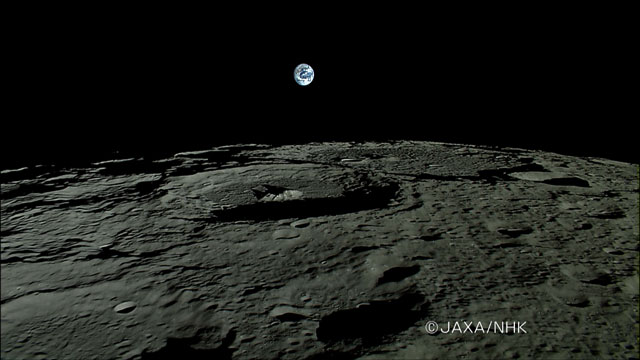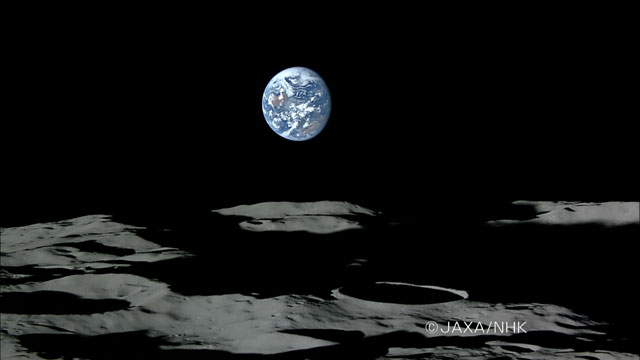KAGUYA (SELENE)
Image Taking of Earth-Rise by HDTV
Japan Aerospace Exploration Agency (JAXA)
NHK (Japan Broadcasting Corporation)
The Japan Aerospace Exploration Agency (JAXA) and NHK (Japan Broadcasting Corporation) have successfully performed the world's first high-definition image taking of an Earth-rise* by the lunar explorer "KAGUYA" (SELENE,) which was injected into a lunar orbit at an altitude of about 100 km on October 18, 2007 (Japan Standard Time. Following times and dates are all JST.)
The Apollo project was the first mission to take images of Earth rising over the Moon. The KAGUYA successfully shot high-definition images of the Earth-rise showing an impressive image of the blue Earth which was the only floating object in pitch-dark space. These are the world's first high-definition earth images taken from about 380,000 km away from the earth in space.
The image taking was performed by the KAGUYA's onboard high definition television (HDTV) for space use developed by NHK. The moving image data acquired by the KAGUYA was received at the JAXA Usuda Deep Space Center, and processed by NHK.
The satellite was confirmed to be in good health through telemetry data received at the Usuda station.
* Note: we use the expression "Earth-rise" in this press release, but the Earth-rise is a phenomenon seen only from satellites that travel around the Moon, such as the KAGUYA and the Apollo space ship. The Earth-rise cannot be observed by a person who is on the Moon as they can always see the Earth at the same position.
"Earth-set" Images taken by the HD camera
(480X270px, no audio)
Earth-rise Images Wide Shot by the HDTV onboard the KAGUYA

Figure 1: Earth-rise image shot taken by the HDTV onboard the KAGUYA
In the image, the Moon's surface is near the North Pole, and the Arabian Peninsula and Indian Ocean can be observed on the Earth.
Earth-set Images Tele Shot by the HDTV onboard the KAGUYA

Figure 2: Earth-set image shot by the HDTV onboard the KAGUYA
In the image, the Moon's surface is near the South Pole, and we can see the Australian Continent (center left) and the Asian Continent (lower right) on the Earth. (In this image, the upper side of the Earth is the Southern Hemisphere, thus the Australian Continent looks upside-down.)

Figure 3: Earth setting image shot by the HDTV onboard the KAGUYA

Figure 4: Relative locations of the KAGUYA, the Moon, and the Earth

Figure 5: Position of the HDTV
| HDTV | |
|
CCD(1920×1080: valid pxcels) 3 chips Three primary colors spectrum by Dichroic Prism Fixed lenses (T: tele camera, W: wide camera) T: 51.23°(horizontal) 30.17°(vertical) W: 15.60°(horizontal) 8.80°(vertical) |
|
|